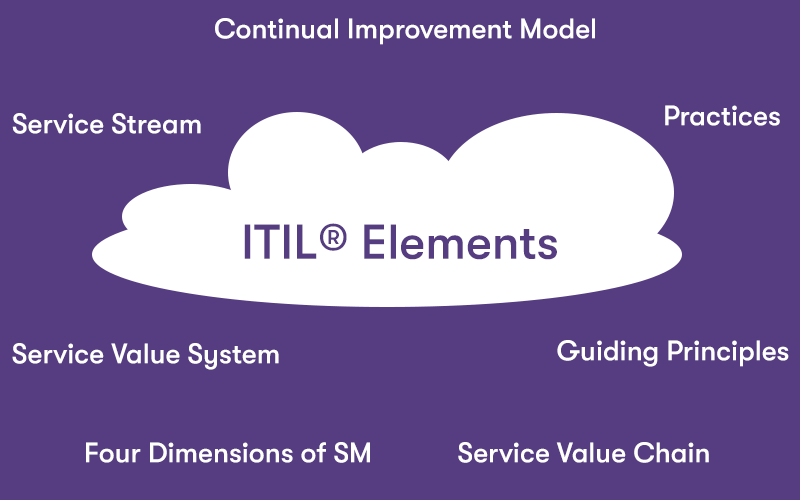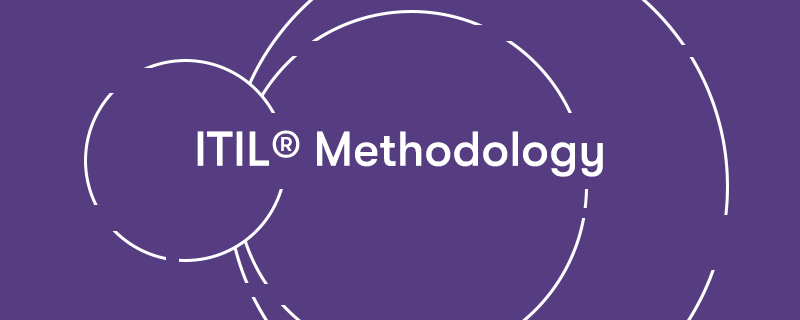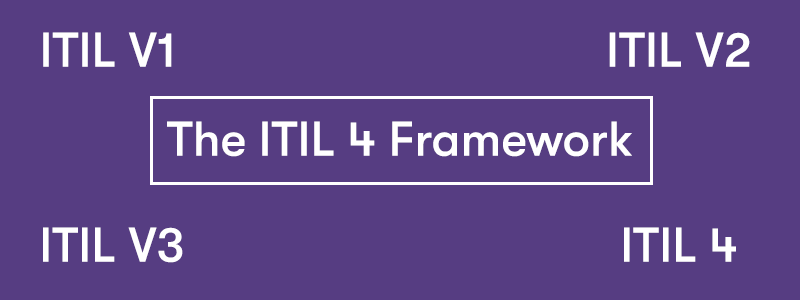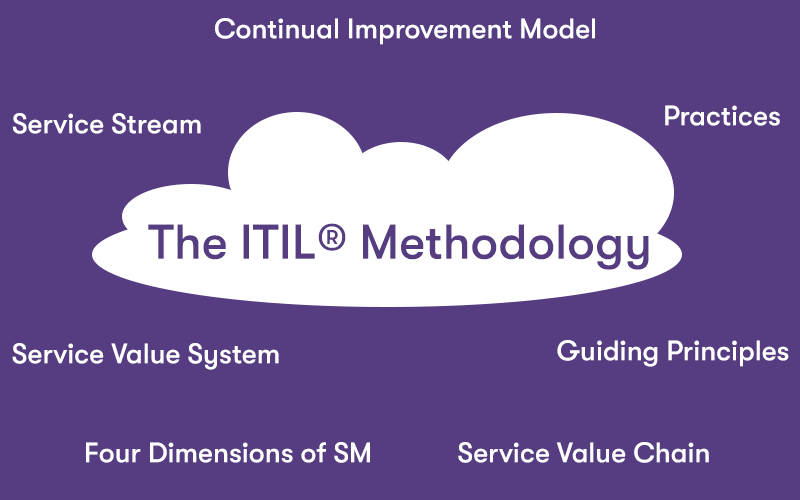ITIL® Methodology
Welcome to our in-depth exploration of the ITIL methodology, a cornerstone of modern IT service management. Originating in the late 1980s, ITIL has evolved from its initial version, focusing on basic IT management practices, to the sophisticated and adaptable ITIL 4 framework we see today. This evolution mirrors the rapidly changing IT landscape, with each iteration, from ITIL V1 to ITIL 4, enhancing its approach to align with emerging technologies and business needs.
ITIL 4, particularly stands out with its integration of Agile, DevOps, and Lean methodologies, emphasising a holistic and flexible approach to service management.
In this blog, we delve into the key elements of ITIL 4, including the Service Value System, guiding principles, and its emphasis on continual improvement, collaboration, and value creation in the realm of IT services.
Join us as we unpack the nuances and benefits of ITIL 4, a framework that has become pivotal in shaping effective IT service management strategies.
(Start your ITIL Journey today with our intensive 2-day ITIL V4 Foundation course)
Is ITIL a methodology?
ITIL is not technically a methodology, but rather a set of best practices and guidelines for ITSM. Unlike a strict methodology which provides a step-by-step process for achieving a specific goal, ITIL is more flexible. It offers a framework of best practices that organisations can adapt and apply according to their specific requirements and the nature of their IT environment. ITIL focuses on aligning IT services with the needs of the business, improving service delivery, and ensuring high levels of customer satisfaction.
What is ITIL?

ITIL 4 is the latest evolution of the ITIL framework, which represents a significant update from the previous version, ITIL V3. ITIL 4 was released in 2019 and introduces several new concepts and practices that reflect the modern digital environment.
ITIL 4 is beneficial for organisations looking to manage IT services in an effective and efficient way, particularly in the context of the fast-paced and complex digital environment. It supports organisations in navigating the Fourth Industrial Revolution, with an emphasis on digital transformation and the management of digital services.
What Does ITIL Stand For?
ITIL stands for Information Technology Infrastructure Library, is it now on its fourth iteration. ITIL 4 does not follow the previous naming schemes of ITIL, ITIL V2, and ITIL V3. This is because PeopleCert wanted to align ITIL with the fourth industrial revolution, so we now have ITIL 4.
What are The Elements of ITIL?

ITIL 4 introduces several key elements that collectively provide a comprehensive and flexible framework for IT service management. These elements are designed to be adaptable to the diverse and dynamic nature of modern IT environments. The key elements of ITIL 4 include:
- Service Value System (SVS)
- Service Value Chain (SVC)
- Four Dimensions of Service Management
- Guiding Principles
- Practices
- Value streams
- Continual Improvement Model
ITIL methodology

The ITIL methodology comprises of multiple elements, that we will cover below:
Service Value System (SVS)
The SVS represents a holistic approach to service management. It integrates various components of the ITIL framework into a cohesive system that focuses on the co-creation of value. This system is dynamic and allows for a high degree of adaptability, making it suitable for a wide range of organisations and service management challenges. The SVS provides a holistic approach to the creation, delivery, and continual improvement of services. It emphasises the importance of creating value through services.
The Four Dimensions Model
This model ensures a holistic approach to service management. These four dimensions are considered critical elements that need to be balanced and integrated to facilitate value effectively and efficiently for customers and other stakeholders through IT-enabled services. It includes considerations of:
- Organisations and People: This dimension emphasises the importance of having the right organisational structure, culture, staffing, and competencies. An organisation must ensure it has the right people with the right skills and knowledge, and that they are organised in a way that supports its objectives. This includes leadership, workforce planning, and employee engagement and satisfaction, which are crucial for effective service management.
- Information and Technology: This dimension covers the information and technology aspects of service management. It includes not only the technology required to deliver services but also the information that is used and managed in the service lifecycle. The focus is on aligning IT with the business, ensuring the right technology is in place, and managing information effectively.
- Partners and Suppliers: Organisations typically work in a network of partners and suppliers, and this dimension acknowledges the importance of these relationships. It involves ensuring that partners and suppliers are integrated into service delivery and that their contributions and risks are managed effectively. This dimension includes relationship management, contract management, and ensuring that partners and suppliers align with the organisation’s culture and objectives.
- Value Streams and Processes: This dimension involves the workflows, processes, and procedures necessary to deliver services. It focuses on designing, managing, and improving these processes to ensure they are efficient, effective, and capable of delivering value. It includes process design, optimisation, and continual improvement.
Guiding Principles
ITIL 4 includes seven guiding principles that were adapted from ITIL Practitioner. These principles are universal and apply to virtually any initiative or aspect of service management. They include:
- Focus on Value: Everything an organisation does should link back directly to value for the stakeholders. This principle emphasises understanding and focusing on what is truly valuable to customers and users.
- Start Where You Are: Before embarking on any change, it's important to understand the current state and not to start from scratch unnecessarily. This involves appreciating existing assets, capabilities, and processes, and identifying opportunities for improvement.
- Progress Iteratively with Feedback: Rather than attempting large-scale changes in one go, this principle advises working in a more agile manner, making smaller, manageable improvements and using feedback to guide the next steps. This approach reduces risk and allows for more flexibility and adaptability.
- Collaborate and Promote Visibility: Breaking down silos and encouraging transparency across all levels of the organisation is vital. Collaboration improves decision-making and ensures that everyone understands how their work contributes to value creation.
- Think and Work Holistically: No service or component stands alone. The principle of working holistically ensures an integrated and coordinated approach to service management, considering how all parts work together.
- Keep It Simple and Practical: This principle involves simplifying processes and procedures, reducing complexity, and focusing on activities that bring value. It encourages removing unnecessary steps that do not contribute to the creation of value.
- Optimise and Automate: Prioritise process optimisation before considering automation. Automating inefficient or unnecessary processes only amplifies their flaws. First, streamline and optimise, then, where appropriate, use technology to automate.
Service Value Chain
The Service Value Chain is a core component of the SVS. It's an operating model for the creation, delivery, and ongoing improvement of services. It consists of six activities: plan, improve, engage, design & transition, obtain/build, and deliver & support. Let’s have a detailed look at each of the six key activities in the Service Value Chain:
- Plan: This activity involves the overall coordination and alignment of the organisation’s resources and capabilities to the strategic objectives. It includes activities like defining policies, ensuring governance, and managing risks. The planning activity ensures that the direction and guidelines are clear for all other activities in the value chain.
- Improve: This is about ensuring continual improvement of products, services, and practices across all value chain activities and the four dimensions of service management. It involves assessing and analysing the current performance and identifying areas for enhancement.
- Engage: Engagement focuses on understanding stakeholder needs, expectations, and feedback. It includes establishing a good relationship with customers, users, and other stakeholders. Activities like communication, marketing, gathering feedback, and managing customer relationships fall under this category.
- Design & Transition: This activity ensures that services are designed effectively to meet stakeholder needs and can be transitioned into the live environment smoothly. It involves designing new or changed services, service components, and processes, and then transitioning them into operation while ensuring that changes are managed effectively.
- Obtain/Build: This refers to the activities involved in obtaining service components from suppliers and integrating them, or building service components internally. It includes aspects of service configuration, acquisition, and development.
- Deliver & Support: This is the execution phase where services are delivered and supported as agreed upon with customers. It involves managing the service levels, resolving incidents and service requests, and ensuring the services are delivered effectively and efficiently to fulfil agreed-upon service commitments.
Each of these activities represents a set of interconnected actions, decisions, or processes that an organisation undertakes to deliver value to its customers and users. The Service Value Chain is adaptable and can be configured in various ways to produce different value streams. This flexibility allows organisations to tailor their approach to service management according to the specific demands and opportunities they face, ensuring they can respond effectively to dynamic customer and business needs.
Practices
In ITIL 4, "Practices" refer to sets of organisational resources designed for performing work or accomplishing an objective. The introduction of the term "practices" in ITIL 4 marks a shift from the more process-focused approach of previous ITIL versions. Practices include not just processes, but also people, information, tools, and other resources necessary for managing and delivering services. ITIL 4 defines 34 practices, which are grouped into three categories:
- General Management Practices: These practices are adopted from general business management domains and have been adapted for service management purposes. They are broad and cover areas that are crucial to effective and efficient service management. Examples of general management practices include risk management, project management, workforce and talent management, and continuous improvement.
- Service Management Practices: These are specific to the activities and capabilities required to provide services. They are more focused on the conceptual aspects of service management. Examples include service level management, service catalogue management, incident management, service request management, and service desk.
- Technical Management Practices: These practices focus on the technology and technical aspects necessary for delivering services. They are particularly crucial in the design, development, and improvement of services that rely on technology. Examples of technical management practices include deployment management, infrastructure and platform management, software development and management, and IT asset management.
Practices in ITIL 4 are designed to be adaptable and flexible, allowing organisations to apply them in various environments and situations. They also facilitate integration with other methodologies and frameworks like Agile, Lean, and DevOps, ensuring a cohesive and comprehensive approach to service management.
Continual Improvement
Continual improvement is a fundamental concept in ITIL 4, emphasising the ongoing effort to enhance services, processes, and practices in service management. This concept aligns with the recognition that the business environment is dynamic, and organisations must continuously adapt and evolve to meet changing needs and expectations. Here are the key aspects of continual improvement in ITIL 4:
- Continual Improvement Model: ITIL 4 introduces a structured approach to continual improvement, represented by the Continual Improvement Model. This model provides a clear and systematic way to approach improvement within organisations. It consists of a series of steps: What is the vision? Where are we now? Where do we want to be? How do we get there? Take action. Did we get there? How do we keep the momentum going? This model can be applied to all levels of the organisation, from strategic to operational.
- Embedding Improvement Culture: Continual improvement in ITIL 4 is not just a process or a set of activities; it's about embedding a culture of improvement throughout the organisation. This involves encouraging a mindset where all employees are actively looking for ways to improve, sharing ideas, and learning from experiences.
- Iterative Approach: The approach to improvement in ITIL 4 is iterative, meaning it advocates for making small, incremental changes rather than large, disruptive ones. This aligns with agile methodologies and allows for more flexibility and responsiveness to changes in the business environment.
- Using Metrics and Measurements: Continual improvement relies heavily on metrics and measurements to assess current performance and identify areas for improvement. It involves setting clear goals and objectives, measuring performance against these, and analysing the data to understand what changes need to be made.
- Alignment with Organisational Objectives: Improvements are not made in isolation but are aligned with the overall strategic goals and objectives of the organisation. This ensures that all improvement efforts contribute towards achieving broader business outcomes.
- Integration with Other Practices: Continual improvement is integrated with other ITIL practices. For example, problem management might identify areas for improvement, while change management might implement the improvements.
- Encouraging Feedback and Collaboration: Continual improvement in ITIL 4 emphasises the importance of feedback from stakeholders, including customers, employees, and suppliers. Collaboration across teams and departments is crucial to identify improvement opportunities and implement them effectively.
Integration with Other Practices
The integration of ITIL 4 with other practices and methodologies is a significant aspect of its design, acknowledging the diverse and dynamic nature of modern IT environments. ITIL 4 is not intended to be a standalone or isolated framework; rather, it is designed to be compatible and complementary with other practices that organisations might be using. This integration is essential for creating a more flexible, responsive, and efficient approach to service management. Here are key areas of integration:
- Agile: Agile methodologies focus on iterative development, customer collaboration, responding to change, and delivering functional products. ITIL 4's flexible and customer-focused approach aligns well with Agile, especially in its emphasis on delivering value quickly and adapting to changing requirements.
- DevOps: DevOps is a set of practices that combines software development (Dev) and IT operations (Ops) aiming to shorten the systems development life cycle and provide continuous delivery with high software quality. ITIL 4 supports this by providing practices for managing services over their lifecycles and facilitating collaboration and communication across various IT teams.
- Lean: Lean methodology aims at maximising value through the minimisation of waste. ITIL 4 incorporates Lean principles by focusing on improving efficiency in service management processes and ensuring that every step adds value to the customer.
- Project Management: Practices like PRINCE2 or PMBOK can be integrated with ITIL 4, especially in areas like change management, project management, and improvement initiatives. ITIL 4 provides the service management context, while project management methodologies offer structured approaches to managing projects.
- Information Security Management: Frameworks like ISO/IEC 27001 for information security management can be aligned with ITIL 4, particularly in managing risks, ensuring compliance, and securing information throughout the service lifecycle.
- Governance Frameworks: ITIL 4 can be integrated with governance frameworks like COBIT to ensure that IT and business strategies are aligned, and that IT services are delivered in a way that meets the organisation's objectives and compliance requirements.
- Quality Management Systems (QMS): Integration with QMS like ISO 9001 ensures that ITIL processes meet quality requirements and that services are consistently delivered to meet customer satisfaction.
- Customer Relationship Management (CRM) and Enterprise Resource Planning (ERP): ITIL 4 can be integrated with CRM and ERP systems to ensure seamless service delivery and effective management of customer and resource information.
This integration capability is a key strength of ITIL 4, making it highly relevant and adaptable to various organisational contexts. By aligning ITIL 4 with other practices, organisations can leverage the strengths of each, leading to improved efficiency, effectiveness, and overall service quality.
The Benefits of the ITIL Methodology

The ITIL methodology offers numerous benefits to organisations looking to improve their IT service management (ITSM). These benefits stem from its comprehensive and flexible approach to aligning IT services with business needs. Here are some of the key benefits of the ITIL 4 methodology:
Enhanced Alignment with Business Objectives
ITIL 4 emphasises the alignment of IT services and operations with the overall business goals and strategy. This ensures that IT contributes effectively to business success and value creation.
Improved Service Delivery
By standardising service management processes, ITIL 4 helps organisations deliver services more efficiently and consistently, leading to improved customer satisfaction and user experience.
Greater Efficiency and Productivity
ITIL 4 provides a structured framework that helps in identifying and eliminating wasteful processes. This leads to optimised resource utilisation, cost reduction, and improved productivity.
Facilitation of Change Management
ITIL 4 introduces flexible practices that support effective change management, enabling organisations to adapt to new technologies and market demands more quickly and with less risk.
Better Risk Management
With its comprehensive approach to risk management and continual improvement, ITIL 4 helps organisations anticipate, identify, and mitigate risks more effectively.
Enhanced Agility and Flexibility
By integrating with agile and DevOps practices, ITIL 4 allows organisations to become more agile and responsive to changing business and customer needs.
Focus on Value Creation
The core principle of ITIL 4 is the co-creation of value, ensuring that every IT service and process is aligned with creating value for customers and stakeholders.
Improved Collaboration and Communication
ITIL 4 encourages a culture of collaboration and transparency within IT teams and across the organisation, leading to better teamwork and shared objectives.
Comprehensive and Holistic Approach
The Four Dimensions of Service Management in ITIL 4 ensure a holistic approach to service management, considering factors like people, information, partners, and value streams.
Continual Improvement
The continual improvement model in ITIL 4 encourages organisations to adopt a culture of ongoing development and optimisation of processes and services.
The ITIL 4 Framework

The development of ITIL from its initial version (V1) to the current ITIL 4 reflects the evolving needs and complexities of IT service management over several decades. Here’s an overview of how ITIL has developed through its various iterations:
ITIL V1
ITIL V1, introduced in the late 1980s, was initially focused on IT service management within the UK government. This version was more a collection of best practices, compiled in over 30 volumes, covering a wide range of IT service management topics. However, it lacked a structured framework and was quite extensive.
ITIL V2
In the early 2000s, ITIL V2 was released, which simplified the original extensive content into 9 focused volumes. This version concentrated on core service support and service delivery processes. ITIL V2 gained significant popularity and was widely adopted beyond the UK government, especially in the corporate sector. It introduced a more structured approach to IT service management and became the standard during this era.
ITIL V3
The next major iteration was ITIL V3, introduced in 2007, with an update in 2011. This version expanded the framework to include the Service Lifecycle concept, comprising Service Strategy, Service Design, Service Transition, Service Operation, and Continual Service Improvement. ITIL V3/2011 emphasised a more comprehensive, lifecycle-oriented approach, integrating business and customer focus into IT service management. It became the basis for the ITIL certification system and was widely recognised as the industry standard for ITSM best practices.
ITIL 4
The latest version, ITIL 4, launched in 2019, represented a significant overhaul of the framework to adapt to the modern digital world. ITIL 4 incorporated insights from Agile, DevOps, and Lean methodologies, introducing the Service Value System (SVS) focused on value co-creation through service relationships. It also emphasised four dimensions of service management for a more holistic approach and included seven guiding principles for a flexible, strategic approach. ITIL 4 expanded and redefined practices, introducing 34 in total, which encompass various aspects of service management. This version was designed to be adaptable and integrable with other practices, acknowledging the dynamic nature of modern IT environments.
The Benefits of The ITIL 4 Framework
The ITIL framework offers numerous benefits for organisations looking to optimise their ITSM. These benefits span across various aspects of service management, contributing to overall organisational efficiency, effectiveness, and alignment with business goals. Key benefits include:
Improved Service Delivery
ITIL provides structured and proven processes for delivering IT services, leading to more efficient, reliable, and consistent service delivery. This improvement in service quality enhances customer satisfaction and trust.
Better Alignment with Business Needs
By aligning IT services with business objectives and customer needs, ITIL ensures that IT supports and drives business success, rather than just functioning as a separate entity.
Enhanced Efficiency and Cost Reduction
ITIL helps in identifying and eliminating redundant processes, leading to more efficient use of resources. This not only reduces costs but also improves service delivery timeframes.
Improved Risk Management
The framework aids in identifying, managing, and reducing IT-related risks. This proactive approach to risk management helps in maintaining service continuity and reducing the impact of incidents and issues.
Facilitates Change Management
ITIL provides guidelines for effective change management, ensuring that changes are implemented in a controlled manner, minimising disruptions and negative impacts on service quality.
Stronger IT Governance
ITIL supports better governance of IT by establishing clear processes, roles, and responsibilities. This clarity helps in decision-making, accountability, and compliance with regulatory standards.
Encourages Continual Improvement
A core principle of ITIL is the focus on continual improvement, driving ongoing enhancements in service management processes and service quality.
Adaptability and Flexibility
ITIL 4, in particular, is designed to be adaptable and compatible with other practices like Agile, DevOps, and Lean, making it relevant in the fast-changing IT landscape.
Global Standard and Best Practices
Implementing ITIL, a globally recognised framework, allows organisations to benefit from established best practices in ITSM. It facilitates benchmarking and improves credibility with customers and stakeholders.
Enhanced Collaboration and Communication
The framework promotes better collaboration and communication within IT teams and across the organisation, leading to more cohesive and effective service management.
Skilled Workforce
ITIL’s comprehensive certification program helps in developing a skilled workforce well-versed in ITSM best practices, contributing to the overall effectiveness of IT services.
Customer-Centric Approach
ITIL 4 emphasises the co-creation of value, focusing on understanding and meeting customer needs and enhancing the overall customer experience.
By implementing the ITIL framework, organisations can establish a systematic and professional approach to ITSM, resulting in improved IT services, enhanced customer satisfaction, and alignment with business objectives.
ITIL Certification Scheme
Final Notes on ITIL Methodology
In conclusion, our exploration of ITIL 4 has offered a comprehensive understanding of its evolution, framework, and benefits. From its inception as ITIL V1 to the adaptable, integrated approach of ITIL 4, this framework has significantly advanced to align with the dynamic digital landscape.
ITIL 4 introduces key elements like the Service Value System, Service Value Chain, and a set of guiding principles, emphasising a holistic, flexible approach to IT service management. Integrating with methodologies like Agile and DevOps, ITIL 4 ensures that organisations are well-equipped to deliver value and achieve business objectives efficiently.
Whether you're new to ITIL or looking to update your knowledge, ITIL 4's focus on collaboration, continual improvement, and customer-centricity makes it an essential framework for today's fast-paced IT environment.


